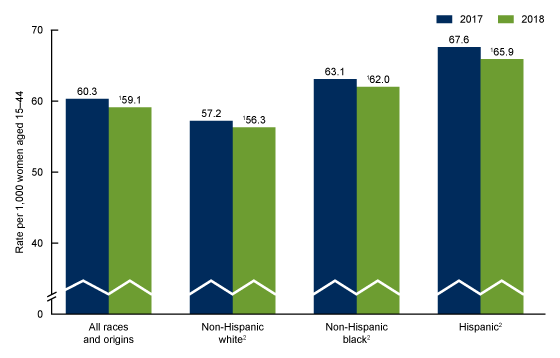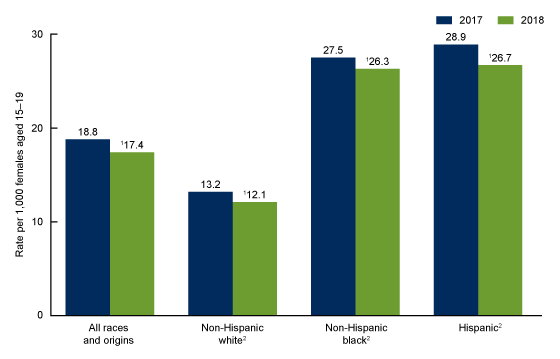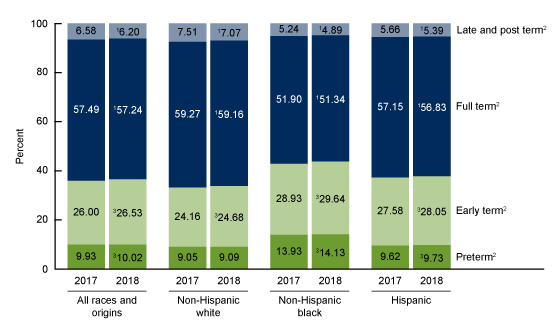(U.S.) – The fertility rate in the United States declined again last year, according to a new report from the US Centers for Disease Control.
According to the report released on Wednesday, “the 2018 general fertility rate fell to another all-time low for the United States.” Researches found the general fertility rate dropped 2% between 2017 and 2018 among girls and women age 15 to 44 nationwide.
Offices noted in 2017, the overall fertility rate for the United States dipped below ‘what’s need for the population to replace itself,’ according to a separate report published by the National Center for Health Statistics earlier this year.
Key findings
Data from the National Vital Statistics System
- The U.S. general fertility rate (births per 1,000 women aged 15–44) declined 2% between 2017 and 2018; fertility rates declined for non-Hispanic white, non-Hispanic black, and Hispanic women.
- The teen birth rate declined 7% from 2017 to 2018 to 17.4 births per 1,000 females aged 15–19. Rates fell for each race and Hispanic-origin group.
- The percentage of vaginal births after previous cesarean (VBAC) rose to 13.3% in 2018 with increases in VBAC deliveries for the three race and Hispanic-origin groups.
- Percentages of births delivered preterm and early term increased from 2017 to 2018, whereas full-term and late- and post-term deliveries declined. These patterns were consistent across race and Hispanic-origin groups.
The general fertility rate declined for all three race and Hispanic-origin groups in 2018.
- The general fertility rate for the United States declined 2% in 2018 to 59.1 per 1,000 women aged 15–44 from 60.3 in 2017 (Figure 1).
- Fertility rates declined for the three largest race and Hispanic-origin groups from 2017 to 2018, down 2% for non-Hispanic white and non-Hispanic black women and 3% for Hispanic women.
- In 2018, the fertility rate was highest for Hispanic women (65.9), followed by non-Hispanic black (62.0) and non-Hispanic white (56.3) women.

Teen birth rates declined for all three race and Hispanic-origin groups in 2018.
- The birth rate for females aged 15–19 declined 7% from 18.8 births per 1,000 females in 2017 to 17.4 in 2018 (Figure 2).
- Among race and Hispanic-origin groups, teen birth rates declined by 4% for non-Hispanic black teenagers and 8% for non-Hispanic white and Hispanic teenagers from 2017 to 2018.
- In 2018, rates for the three groups were lowest for non-Hispanic white teenagers (12.1), followed by non-Hispanic black teenagers (26.3) and Hispanic teenagers (26.7).

The distribution of births by gestational age shifted to earlier deliveries from 2017 to 2018.
- The percentage of all births delivered at less than full term (less than 39 weeks) increased from 2017 to 2018 with rises seen among both preterm (9.93% to 10.02%) and early-term (26.00% to 26.53%) births (Figure 4).
- Concurrently, the percentages of births delivered at full term and late and post term declined. Full-term births were down from 57.49% in 2017 to 57.24% in 2018; late- and post-term births declined from 6.58 % to 6.20%.
- Both preterm and early-term birth rates rose for each of the race and Hispanic-origin groups from 2017 to 2018, although the increase in preterm births to non-Hispanic white mothers was not significant.
- Infants delivered to non-Hispanic black mothers were more likely to be born preterm (14.13% compared with 9.09% for non-Hispanic white and 9.73% for Hispanic mothers in 2018) and early term (29.64% compared with 24.68% and 28.05%, respectively).

Birth certificate data for 2018 show continued declines in childbearing in the United States overall and among the three largest race and Hispanic-origin groups. The 2018 general fertility rate fell to another all-time low for the United States and for each race and Hispanic-origin group shown in this report (1,2). Teen childbearing also declined to record lows overall and for the three race and Hispanic-origin groups (1–3). VBACs increased in 2018; VBACs have been on the rise since 2016, when national data for previous cesarean deliveries became available again in the national birth certificate data (2). Preterm and early-term deliveries continued to rise in 2018 and have been trending upward since 2014 (2).
These 2018 data mark the third year for which national data for most items that were new to, or changed with, the 2003 revision of the U.S. Standard Certificate of Live Birth, including VBAC and repeat cesarean, have been available.


